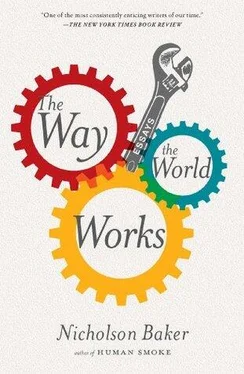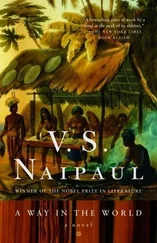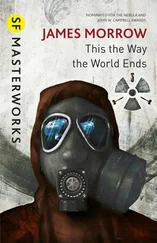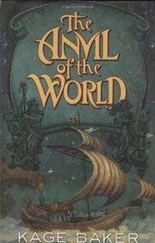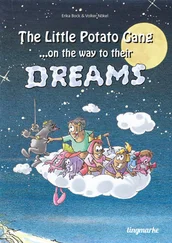Nicholson Baker - The Way the World Works
Здесь есть возможность читать онлайн «Nicholson Baker - The Way the World Works» весь текст электронной книги совершенно бесплатно (целиком полную версию без сокращений). В некоторых случаях можно слушать аудио, скачать через торрент в формате fb2 и присутствует краткое содержание. Год выпуска: 2012, Издательство: Simon & Schuster, Жанр: Публицистика, Критика, на английском языке. Описание произведения, (предисловие) а так же отзывы посетителей доступны на портале библиотеки ЛибКат.
- Название:The Way the World Works
- Автор:
- Издательство:Simon & Schuster
- Жанр:
- Год:2012
- ISBN:нет данных
- Рейтинг книги:4 / 5. Голосов: 1
-
Избранное:Добавить в избранное
- Отзывы:
-
Ваша оценка:
- 80
- 1
- 2
- 3
- 4
- 5
The Way the World Works: краткое содержание, описание и аннотация
Предлагаем к чтению аннотацию, описание, краткое содержание или предисловие (зависит от того, что написал сам автор книги «The Way the World Works»). Если вы не нашли необходимую информацию о книге — напишите в комментариях, мы постараемся отыскать её.
), here assembles his best short pieces from the last fifteen years.
The Way the World Works
OED
Modern Warfare 2
Through all these pieces, many written for
, and
, Baker shines the light of an inexpugnable curiosity.
is a keen-minded, generous-spirited compendium by a modern American master.
The Way the World Works — читать онлайн бесплатно полную книгу (весь текст) целиком
Ниже представлен текст книги, разбитый по страницам. Система сохранения места последней прочитанной страницы, позволяет с удобством читать онлайн бесплатно книгу «The Way the World Works», без необходимости каждый раз заново искать на чём Вы остановились. Поставьте закладку, и сможете в любой момент перейти на страницу, на которой закончили чтение.
Интервал:
Закладка:
When Bruno finished work for the day, he would hitch his gondola like a horse not far from Peggy Guggenheim’s palazzo (Bruno’s father was Peggy Guggenheim’s gondolier for a time), in the little canal where Susie shared a mosaic studio with a Russian woman. He would peek in the little window that was in the door and greet her; she would scoop away the wet cement from her work-in-progress (she was using pieces of old mirror-glass a lot then) and come out with him. In time Susie learned to row herself, and they rowed a lot — to the Rialto to shop, to entertain dinner guests, to carry Susie’s heavy mosaics to her show. They, together with an American man and Bruno’s brother Ambrogio (who was a gondolier until elbow problems forced him to become a businessman), competed in the first Vogalonga in 1975—the Vogalonga being a noncompetitive marathon open to any kind of international oar-powered craft. “She should be home washing the dishes!” some people called from the shore (in Italian). Others called out, “ Viva la donna!”
They got married in Venice’s City Hall in 1978; their first child, Giacomo, learned the basics of rowing when he was two, by holding a broom and standing in a wooden cradle that Bruno had built for him. Giacomo is now eighteen; he is not sure whether he wants to be a trumpet player, or a gondolier, or both. Last year he won the youth-division Regata Storica and every other race he entered. I asked him if he had any rowing tips. “You have to make the boat always go forwards and not go back,” he said. “The oar has to come in strong to come out sweetly and then go back fast.” Bruno is not a regatta-racer himself, but Giacomo admires his father’s virtuosity. “Everybody can go fast, if you train,” he said, “but not everybody can go fast in the canals.”
Bruno has the ferri, the prow and stern ornaments, of various relatives mounted on the walls and ceilings of their house. He recently spent three winters renovating an ornately filigreed felze made around the turn of the century, the sort of thing that Henry James or William Dean Howells would have cruised around in. (“I don’t know where, on the lagoon, my gondolier took me,” James wrote; “we floated aimlessly and with slow rare strokes.”) Bruno has a collection of old gondola components he keeps in a low-ceilinged storage room near where he grew up, in the Dorsoduro. (His family moved to the Giudecca in 1960, after canal water began flooding into Bruno’s room.) On the wall are portraits of gondolier relatives, old paintings of regatta champions, and a photograph of Susie and him leaving City Hall on their wedding day. The radio is always softly playing. “I like old things, anyway,” he said as he uncovered more and more of his collection of cloth-shrouded gondoliana. He owns two gondolas — the one that he rowed for our wedding (which seemed plenty fancy to us at the time), and a budget-busting wedding sloop that he commissioned Tramontin to make for him in 1990. Its stern-piece is an elegant twist of steel curving around a fernlike decorative whorl incised with the Palmarin coat of arms and the initials “PB.” (“Handmade by a friend of mine,” Bruno said.) The chairs are the ones his uncle used on his wedding gondola, re-gilded; Susie made the embroidered pillows and found the putti-and-flower pattern that the wood-carver chipped into the top panels. On the prow there is a small gold man holding a bottle of wine that Bruno had cast from a statue on an old clock he owns — the figure serves, as Bruno sees it, as the hostly Bacchus, saluting all passenger-guests and wishing them a good journey in his boat. Bruno hesitates to say how much it all cost: “Thirty thousand dollars would not be enough,” he says. The boat’s name is Aurelia Stephanie, after his daughter.
I walked with Bruno one morning to pick up the sealed results of a heart test from the Ospedale Civile. He tore open the white envelope on the front steps of the building, in front of a fifteenth-century trompe l’oeil stone facade, but the results were numerical and abbreviated and impossible to interpret. Not long ago he experienced what he calls “an episode of fast heartbeating” during an argument over the phone with Giacomo. He hasn’t felt any flutters while he is rowing, though. Inactivity is his enemy. “The more I work hard, the better I feel. If I fatigue, if I feel nice and tired, I feel much better.” One of the difficult things about his job is the waiting — standing in the heat in front of the Doge’s Palace. Passersby ask him the same questions hundreds of times a day, and have their pictures taken next to him as if he’s a monument. The sunlight reflects off the walls of the palace and off the water; it is like standing in a toaster.
We stopped at the Rialto at a small clothing store; I stood outside guarding a wicker basket that Bruno had found in a pile of trash by a canal while Bruno went inside and bought two pairs of black gondolier’s pants. Then he told me another story about his grandfather Ambrogio. “In the winter, there was very little to support the family, but he was a grand man,” he said. Ambrogio had a big red handkerchief, in which he put three cabbages. “Then he bought three necks of turkey — only the necks. He pinned the necks of turkey outside the handkerchief, and the cabbages were inside. Passing by San Vio like that — he wanted everybody to think he had three turkeys inside.”
Bruno’s childhood was not prosperous, either. He is self-educated; he left school after fifth grade and got a job carrying boxes of tripe across town on his shoulder. Later he worked for an old gondolier, cleaning out his boat and doing substitute work. Eventually he inherited his father and grandfather’s gondolier’s license. The licenses are valuable nowadays, like cab medallions. Recently someone introduced a measure that would prohibit the transfer of a license to one’s offspring. “Someone would make me not be able to give it to my son, eventually?” Bruno asks, incredulously. “No, no, ridiculous.” It was voted down. On the other hand, Bruno half hopes that he is the last Palmarin gondolier — that Giacomo will choose a different profession. “Not that I don’t like this job, but I think sometimes it is restricted, if you know what I mean, limited.”
He thinks of owning a place in the mountains, far from boats, and raising land creatures — horses, pigs, chickens. Venice can seem paved-over and confining. English and French he learned by spending winters abroad when he was in his twenties. “It didn’t mean when I went to Paris I did the grand life, or to London. But— ah! — I breathe more. The life here was to be a gondolier, to get fiancé with some nice young Venetian and then eventually get married, and then, that is life.” When he met Susie it was different. “Modestly, I had some opportunities here,” he said. “But she was not suffocating. A Venetian woman would be suffocating, you see. And so something grew in between us. She very often says to me, ‘You should have married a Venetian woman, cooking well, and so on.’ But she doesn’t know how much happy she made me, anyway.”
If Giacomo does decide in time to be a gondolier, he can expect to make a comfortable, if seasonal, living. Tariffs have risen steadily, and each gondolier is a member of a cooperative that pools income and pays a percentage of health insurance and pension expenses. “The gondola is alive because of money,” Bruno reminded me. “I am no angel myself.” But Bruno is troubled by how narrowly income-obsessed some of his colleagues are now. They are relinquishing their traditional roles as ambassadors and civic proxies. “There used to be a gondolier who was called Zar delle Russie, ‘Russian Czar,’ because he was a very pompous guy,” Bruno told me. “When somebody came to Venice, he used to go to Piazza San Marco and say, ‘The gondoliers welcome you, sir.’ And shake the hand. It was a bit of pathos, if you like. But it was done in an elegant way. Now gondoliers, what are they? We have no identity anymore. We have no past. We have put everything in money.”
Читать дальшеИнтервал:
Закладка:
Похожие книги на «The Way the World Works»
Представляем Вашему вниманию похожие книги на «The Way the World Works» списком для выбора. Мы отобрали схожую по названию и смыслу литературу в надежде предоставить читателям больше вариантов отыскать новые, интересные, ещё непрочитанные произведения.
Обсуждение, отзывы о книге «The Way the World Works» и просто собственные мнения читателей. Оставьте ваши комментарии, напишите, что Вы думаете о произведении, его смысле или главных героях. Укажите что конкретно понравилось, а что нет, и почему Вы так считаете.
